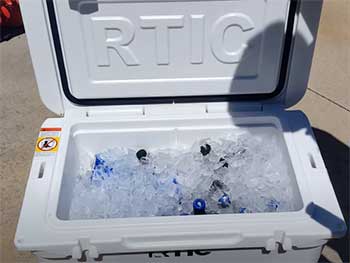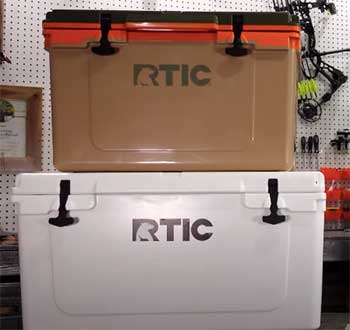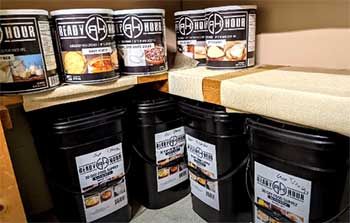When it comes to keeping food and drinks chilled for picnics, camping trips, tailgates, and other outdoor activities, a high-quality cooler is essential. Two cooler brands that often top people’s lists are Coho and RTIC.
But which one is better?
Let’s take an in-depth look at the pros, cons, features, and performance of Coho and RTIC coolers to help you decide which is best for your needs.
A Brief Comparison Table
| Feature | Coho Cooler | RTIC Cooler |
| Construction | Roto-molded polyethylene, polyurethane insulation | Roto-molded polyethylene, foam insulation |
| Ice Retention | 5-10 days | 6-10+ days |
| Size Options | 45 quart, 75 quart | Many sizes from 20 quart to 145 quart |
| Shape | Angled interior to maximize capacity | Traditional box shape |
| Latches | Metal toggle latches | Rubber T-latches |
| Handles | Fixed rope or side handles | Removable rope handles |
| Mobility | Non-slip feet | Optional wheel kits |
| Warranty | Lifetime warranty | 5 year limited warranty |
| Price | $200 – $350 | $160 – $350 |
| Made In | USA | Asia |
Overview of Coho Coolers

Founded in 2019, Coho is a relatively new player in the cooler market.
But in their short time, they’ve made quite the impression with their roto-molded coolers constructed using a proprietary polyurethane-insulated wall.
Coho touts their coolers as being made in the USA with durable materials equipped with smart features.
Some pros of Coho coolers include:
- Innovative design – Coho coolers have a unique obtuse angle shape to maximize interior volume. This allows you to pack more food and drinks inside.
- Durable construction – They’re made using a high-density polyethylene shell and polyurethane insulation for superior ice retention. The lid has a freezer-grade gasket for an air-tight seal.
- Easy latching system – Coho lids attach securely with toggle latches rather than rubber latches that can break over time.
- Non-slip feet – Feet with traction hold the cooler in place.
- Built-in bottle opener – A subtle but handy feature is the built-in bottle opener on the side.
Potential downsides of Coho coolers include:
- New company – As they don’t have a long track record, it’s hard to assess long-term durability.
- Limited sizes – Coho currently only makes 45 quart and 75 quart coolers, while brands like RTIC have many more sizes.
- Price – Coho coolers are on the more expensive end, coming in between $200-$350.
Also Read: Comparison of Moosejaw And Lifetime Coolers.
Overview of RTIC Coolers
Texas-based RTIC (short for “Roto-Molded Ice Chest”) has been selling roto-molded coolers since 2015. They market themselves as a go-to cooler brand for hunters, campers, and outdoor enthusiasts.
Some of the pros of RTIC coolers are:

- Variety of sizes – RTIC offers a huge selection of cooler sizes ranging from soft-sided models to massive 140+ quart monsters. You’ll find the right size for your needs.
- Rotomolded construction – Like higher-end brands, RTIC coolers feature rotomolded polyethylene shells and foam insulation for optimal ice retention.
- Bear-proof – The coolers are certified bear-resistant and ideal for outdoor activities in bear country.
- Affordable prices – Especially compared to premium brands like Yeti, RTIC coolers are very competitively priced given their quality.
- Wheel kits available – For large coolers, you can purchase wheel attachments to make transportation easy.
Some potential RTIC downsides to consider:
- Not made in USA – While good value, RTIC coolers are made in Asia rather than USA-constructed.
- Condensation – The exterior can “sweat” with condensation build up more than some other brands.
- Lid fit – Some users complain of gasket leaks on the lid with RTICs.
Ice and Temperature Retention Comparison
The most important performance factor for any cooler is how well it retains ice and keeps contents cold. Both Coho and RTIC use thick insulation in their walls to provide excellent cooling capabilities.
Independent ice test results show:
- Coho 75 quart cooler kept ice for 5.5 days in 90 degree heat.
- RTIC 65 quart cooler maintained ice for 6.5 days in 90 degree heat.
So in direct ice retention comparisons, RTIC seems to edge out Coho by about a day. But both maintain ice remarkably well for days on end if pre-cooled properly before use.
The major difference is Coho only makes up to 75 quart sizes currently, while RTIC offers far larger 140+ quart models.
Also Read: Differences Between Yeti And Yukon Outfitters Coolers.
Build Quality Comparison

Coho and RTIC are both known for their rugged, durable builds using roto-molded polyethylene and foam insulation.
Both brands should easily handle outdoor use and abuse for years.
The latches and handles are one difference.
Coho uses metal toggle latches that feel very sturdy, while RTIC has molded-in rubber T-latches.
Coho’s metal handles are fixed in place while RTIC has removable rope handles.
For mobility, Coho 45 has built-in rope handles on the sides. RTIC instead offers wheel attachments as an optional accessory.
In terms of grip, RTIC’s exteriors are textured for easy grabbing. Coho counters with rubber non-slip feet to prevent sliding.
Due to it’s thicker walls, Coho’s coolers feel a bit more premium in overall construction. But RTIC is no slouch in build quality either for the lower price.
Visual Appearance Comparison
Coho coolers have a streamlined look with minimal exterior logos and come in colors like bone white, blue, or gray. RTIC has more prominent branding and comes in wider color choices like blue, pink, orange, gray, and more.
If you want a cooler that blends into outdoor environments, Coho’s more neutral and minimalist looks are great. RTIC offers brighter, funkier colors for those that want more visible coolers.
In terms of external dimensions, RTIC tend to be a little larger than Coho at a given quart capacity. This is because Coho maximizes interior storage with its obtuse internal angles.
Cost Comparison
When it comes to price, RTIC consistently beats out Coho:

- A Coho 45 quart cooler costs $259.
- A comparable RTIC 45 quart costs $169.
- A Coho 75 quart costs $349.
- A similar RTIC 65 quart costs $289.
Clearly, RTIC offers significantly better value for money overall.
The price differences can really add up if you need multiple large coolers.
However, keep in mind that Coho’s unique shape does allow you to store more inside vs a typical box-shaped RTIC.
So while RTIC is far cheaper, Coho does provide enhanced interior capacity.
Warranty Comparison
The warranty coverage also differs quite a bit between the two brands:
- Coho offers a lifetime warranty on their coolers, one of the best in the industry. This covers any manufacturer defects for as long as you own the cooler.
- RTIC coolers come with a 5 year limited warranty. This is decent coverage but not lifetime protection.
So if warranty duration is important to you, Coho is the clear winner here. Their lifetime guarantee really adds value and peace of mind.
Also Read: Is Coho 55 Quart Rotomolded Cooler Worth It?
Frequently Asked Questions (FAQ)
Yes, Coho is considered an excellent and reputable cooler brand. They make high-end roto-molded coolers with great insulation and ice retention. Their unique angled interior shape lets you store more while keeping a smaller exterior size. Overall Coho makes very good quality and innovative coolers.
Based on independent ice tests, a properly pre-chilled 75 quart Coho cooler kept ice solid for over 5 days in 90 degree Fahrenheit heat. With maximum pre-cooling and minimal opening, Coho claims you can expect up to 10 days of ice retention in ideal conditions. Their superior insulation really locks in the cold.
RTIC coolers are just as good as YETI brand in terms of real world performance. In multiple ice retention tests and durability tests, RTIC performs on par with YETI. RTIC uses similar rotomolded construction with thick insulation. The main difference is RTIC costs significantly less than the more premium-priced YETI models. So you get great quality and value with RTIC.
Yes, YETI did sue RTIC in 2016 alleging patent and trademark infringement. YETI argued the visual similarities and names like “Tundra” too closely mimicked YETI design and branding. However, the lawsuit was settled out of court in 2017. RTIC agreed to change in some design aspects while keeping core cooler features. This lawsuit is why RTIC cooler aesthetics differ somewhat today compared to early models that more closely resembled YETI.
Final Thoughts
At the end of the day, choosing between Coho and RTIC coolers comes down to your needs:
For keeping ice frozen longer on extended trips, RTIC seems to have a slight performance advantage over Coho based on ice retention tests. The larger size range is also a major plus.
RTIC is the better choice if cooler duration and maximum capacity is critical.
However, Coho coolers have excellent ice retention as well, just slightly less than RTIC. The unique shape allows packing more inside a smaller exterior. Coho feels a bit more premium in build.
And the lifetime warranty provides unbeatable protection. Coho is preferable if you value enhanced capacity, premium feel, and lifetime guarantee.
Overall you really can’t go wrong with either brand. Both make high-performing, durable coolers capable of keeping food and drinks chilled for days on end. Pick the one that best matches your specific cooling needs and budget.

